Almost a year has gone by since I wrote Part One of the blog on plant dormancy, and it has given me time to think about and evaluate the freezes, the damage and the process to restore.
** Go back and read Part One to take a refresher of what dormancy means in the plant world. **
I’ve been able to assess all the damage that the freeze actually did to our lavender plants and cherry trees. I delayed my writings on this topic because it took a whole season to really understand what happened out in the field.
Since I wrote Part One of the blog, here at Sage Creations, we removed at least 3500 plants between April and October. The species and cultivars varied, and in general, we found the freeze was indiscriminate to which type it killed or severely damaged.
My findings were that the age of the plants was more of a factor than the species.
Interestingly, I found this true when talking to other lavender growers in Colorado as well. We mainly removed plants that were newly planted the season before and many plants that had hit their 10th to 12th years in production. I found the freeze-damaged plants that were older (hence more vulnerable to a severe freeze), and those that were younger, (not having had enough time to develop a larger root system and canopy). This was a bummer, to say the least, but many farmers know, you have to carry on, and prepare for replanting.
I quickly learned how to remove massive amounts of plants more efficiently. It took a side spade attached to a tractor — which pulled the plants out from the soil completely — then letting plants dry out in the field for a few weeks before disking the plants and incorporating them back into the soil. By the time we disked the plants they were brittle enough to break apart and were easily incorporated back into the soil.
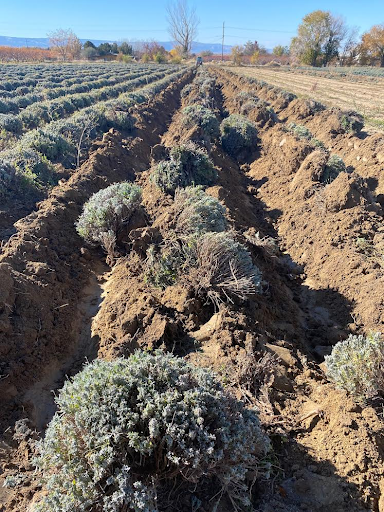 L.ang. Folgate removal with spade attached to tractor.
L.ang. Folgate removal with spade attached to tractor.
The plants that were planted amongst good rows of lavender or in smaller accessible areas we pulled by hand-what a chore! Removing weed fabric in the larger fields was a good work out, first we removed all the staples (and saved them) then we attached the end of the fabric to the end of the ATV and drove from the beginning of the row forward, pulling the fabric up as we moved along the bed. It took a full day to remove 1800 plants this way. I must say — better than removing each plant by hand. Without fabric, this task would have been much easier.
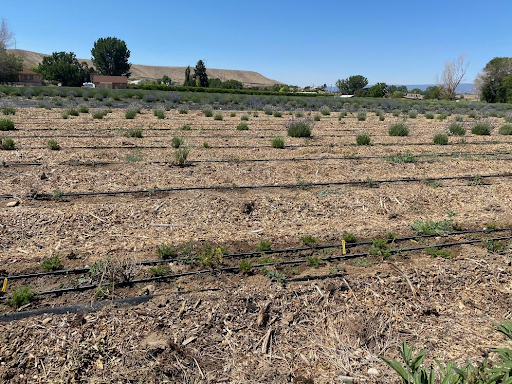 Spring 2021 — at least 1,000 new plants lost.
Spring 2021 — at least 1,000 new plants lost.
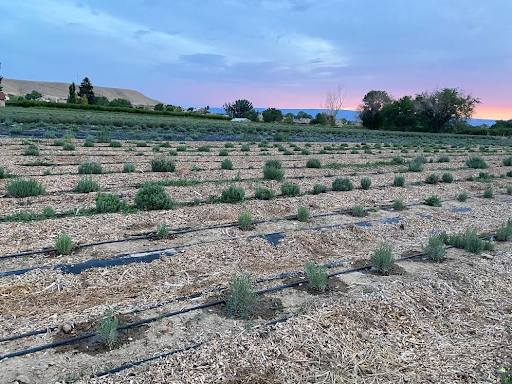 Same field, filled in the gaps. Photo taken in October 2021.
Same field, filled in the gaps. Photo taken in October 2021.
It is now mid-January and we had agreeable Fall weather, meaning steady and consistent temperatures through the Fall and into December. Temperatures steadily decrease in 5 to 10-degree increments. Plants had plenty of time to ease into winter dormancy. What you wish most for your perennial crops!
I chose not to cover my lavender plants going into winter in order to prevent the burning of plants under row covers and focus on my more delicate crop of Helichrysum italicum. The choices one makes when short on time and resources…
So far the weather has been cooperating. My field rotation of these new open fields and areas is still formulating.. These slower months let me plan and ponder. Where I removed plants, I will have cover crops (a try of chickpeas and peas once again) and rotate with other annual crops, such as flowers, spring cover mix, and winter rye. Knowing that this removal will take a big hit on my overall production and yields, I did some interplanting in the Spring and Fall to make up for some of the losses in yields that are anticipated in the future.
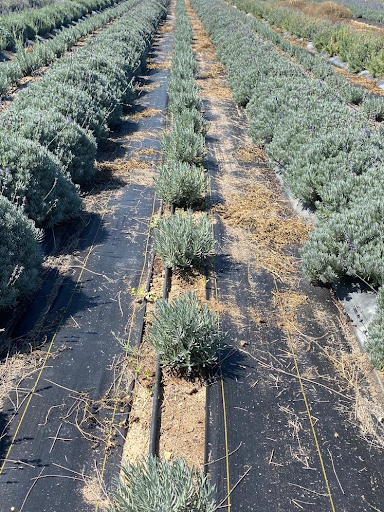
Interplanted L.xi. Riverina Thomas in May 2021 – photo taken October 2021 while repairing and accounting for field crop rotation.
Going into Spring things to think about and prepare for…
The three R’s – Winter is a time to plan your plant removals, recoveries, and replants. Think about the plants you may need to fill in the gaps in your rows, the new fields you want to create, and which aged, low productivity plants you would like to remove and replace with new lavender plants or crop rotate.
By the end of April–the beginning of May in the high desert, you can begin to tell which plants made it or didn’t.
There are a few ways you can tell if your plant is still in a dormancy period or dying.
Try these three simple tests:
The Snap Test. You can tell if a plant is dead or dormant by doing a snap test. Choose the end of a stem or branch about as big around as a pencil down into your lavender shrub. Try to snap the branch in half. A dead branch or stem will snap easily and have a dried-out look on the inside-a dark brown to blackish color. However, a dormant branch will bend and when it splits open will reveal a hint of green inside.
The Scratch Test. You can also use the scratch test to see if your plant is dormant or dying. Choose a young stem and use your fingernail or a sharp knife to scratch at the bark. If there is green, then the plant is still alive. If it’s brown, try again, but close to the roots.
If your plant is in a pot you can also do a Root Inspection. A plant that is dormant will have healthy roots even if the rest of the plant still looks dead. If necessary, you can remove the plant from the pot and see if the roots look healthy or have shriveled and died and appear black in color.
What happens when you receive a freeze in the late Spring after your lavender or woody and semi woody perennials have broken dormancy.
Just when you think spring was here to stay, Jack Frost pays a late season visit and leaves an ugly mess behind. All too often, unseasonably warm temperatures in late winter and early spring can cause big problems in our gardens and lavender fields.
These ‘spring-like’ temperatures often result in many plants and trees breaking dormancy prematurely. This sudden drop to below freezing can wreak havoc on tender new growth. The beautiful Spring temps have the lavender shrub beginning to form a beautiful green mound, and spikes are emerging and… WHAM the evening temp goes below freezing. You wake up to a drooping lavender stem and some frostbite on those beautiful green leaves. Fortunately, this type of freeze or frost does not completely kill a lavender plant but may affect your yields. There are things to look for and do when this happens.
Besides the potential season-ending loss of flowers that bloom on or before June, the plants themselves usually fare much better than when you have a premature freeze in the fall before plants have gone into dormancy. You may choose to remove dead flower buds for cosmetic purposes. Otherwise, they’ll fall off on their own eventually and new spikes and flower buds may emerge, but your yields may be impacted.
Also, lavender shrub’s newest tissue grows towards the top of the plant. Older foliage further down into the plant may or may not show signs of damage. Signs of damage include brown or black discoloration or limpness.
Wait to prune back these plants until it is obvious that new growth will not be emerging from the branches. Usually, by late May early June, new growth will have appeared.
Lastly, here are things you can do to prevent growth from occurring too early, or plants coming out of dormancy too soon and becoming susceptible to Spring frosts.
Delay spring pruning as late as possible. This can encourage new growth too soon and the plant will be susceptible to early frosts
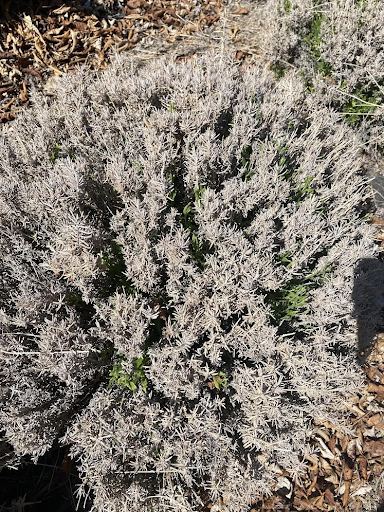 Before delayed pruning
Before delayed pruning
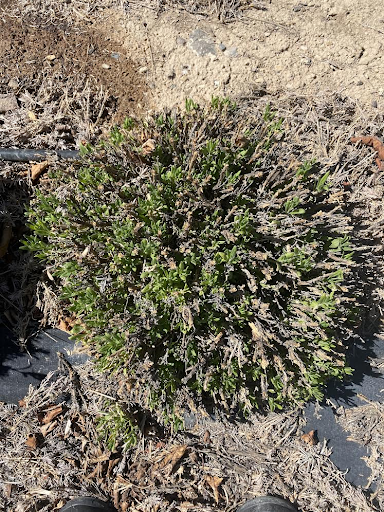 After delayed pruning
After delayed pruning
Do not fertilize in the Spring. Fertilizing with nitrogen stimulates growth.
Water in late Winter. If you experience a dry late winter and have access to winter watering this will prevent early growth. Dry soil is known to encourage new growth too soon.
So… carry on, pivot, and plan ahead. In order not to get too down, I try to see this as an opportunity to try new cultivars, new planting methods, and plant other types of crops.
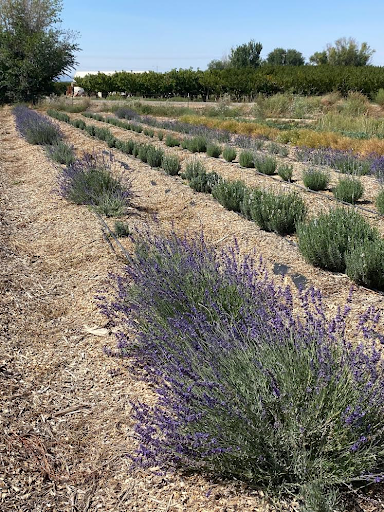 Interspersed replant inside first year plant block. 2020 and 2020 plants combined. Photo taken October 2021.
Interspersed replant inside first year plant block. 2020 and 2020 plants combined. Photo taken October 2021.


alan hallock
This was very useful and interesting, thank you. I am a retired farmer in Illinois trying to start a lavender field. We had a dry fall and lots of warm weather then hit with cold temperature. I was not concerned with the dry weather because normally I struggle with too much moisture. We now are getting below 0 temperatures and my plants have areas that are totally dried out, leaves come off in your hand. My younger plants have taken the hardest hit, maybe not enough root growth to support plant during the dry fall. Another year and more experience.
נערות ליווי
אני מאוד ממליץ על אתר הזה כנסו עכשיו ותהנו ממגוון רחב של בחורות ברמה מאוד גבוהה. רק באתר ישראל נייט לאדי https://romantik69.co.il/
נערות ליווי
אני מאוד ממליץ על אתר הזה כנסו עכשיו ותהנו ממגוון רחב של בחורות ברמה מאוד גבוהה. רק באתר ישראל נייט לאדי https://romantik69.co.il/
נערות ליווי
אני מאוד ממליץ על אתר הזה כנסו עכשיו ותהנו ממגוון רחב של בחורות ברמה מאוד גבוהה. רק באתר ישראל נייט לאדי https://romantik69.co.il/